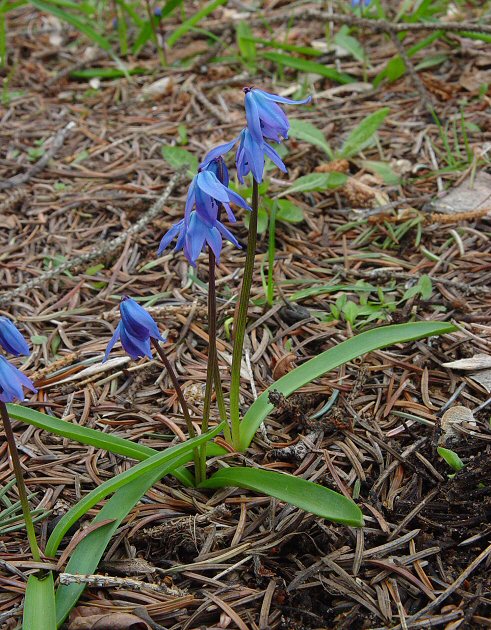Scilla siberica Andrews
Squill

Introduced
CC = *
CW = 5
MOC = 2
© DETenaglia
Scilla siberica AndrewsSquill | |
 |
Introduced CC = * CW = 5 MOC = 2 |
© DETenaglia |
|
Family - Liliaceae Stems - Aerial stems to +15cm tall, erect, green, glabrous, angled, purplish near apex, from small bulb. Bulb +/-1cm in diameter, with fibrous roots. Leaves - Basal, typically 2-3 per plant, folded longitudinally at base, entire, linear to narrowly oblong, to +/-20cm long, 1.5cm broad.
Inflorescence - Few flowered raceme terminating the aerial stem, sometimes just single-flowered. Pedicels purple, 6-9mm long, glabrous, subtended by small scales. Scales light purple, succulent, to 1.5mm long. Flowers - Tepals 6, 1.5-1.7cm long, 5-6mm broad, blue, glabrous, oblong to narrowly ovate, entire, with a single blue midvein. Stamens 6, adnate to the base of the tepals. Filaments white, erect, 8mm long, glabrous, compressed at base. Anthers blue, 2.1mm long. Style 6mm long, purple, glabrous. Ovary green, superior, 4mm long, 3-angled, 3-locular. Placentation axile. Seeds (ovules) many.
Flowering - March - April. Habitat - Mesic bottoms, moist slopes, roadsides, fields. Origin - Native to Russia. Other info. - This attractive little garden species has escaped to a few counties in Missouri but is widely cultivated. Where escaped it can be quite aggressive and locally abundant. The typical flower color is blue but colors vary depending on the cultivar. So far, only the blue flowered plants are found wild in Missouri. Like most plants in the genus, this species is toxic. Photographs taken in Marquette, MI., 4-30-04. |